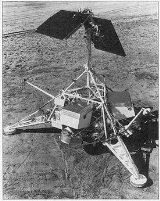
Surveyor 4
Encyclopedia
Surveyor 4 was the fourth lunar lander in the American
unmanned Surveyor program
sent to explore the surface of the Moon
.
This spacecraft
crashed after an otherwise flawless mission; telemetry contact was lost 2.5 minutes before touchdown.
This spacecraft was the fourth in a series designed to achieve a soft landing on the moon and to return photography
of the lunar surface for determining characteristics of the lunar terrain for Apollo
lunar landing missions. Equipment on board included a television camera
and auxiliary mirrors, a soil mechanics surface sampler, strain gauge
s on the spacecraft landing legs, and numerous engineering sensors. After a flawless flight to the moon, radio
signals from the spacecraft ceased during the terminal-descent phase, approximately 2.5 min. before touchdown. Contact with the spacecraft was never reestablished, and the mission was unsuccessful. The solid fuel retro rocket may have exploded near the end of its scheduled burn.
Like Surveyor 3
, Surveyor 4 was equipped with a surface claw (with a magnet in the claw) to detect and measure ferrous elements in the lunar surface. The mission was completely successful until all communications were abruptly lost 2 seconds prior to retrorocket cutoff at 02:03 UT on 17 July 1967, with only 2.5 minutes left to landing on the Moon. The landing target was Sinus Medii
(Central Bay) at 0.4° north latitude and 1.33° west longitude. NASA concluded that the lander might have exploded when contact was lost.
United States
The United States of America is a federal constitutional republic comprising fifty states and a federal district...
unmanned Surveyor program
Surveyor program
The Surveyor Program was a NASA program that, from 1966 through 1968, sent seven robotic spacecraft to the surface of the Moon. Its primary goal was to demonstrate the feasibility of soft landings on the Moon...
sent to explore the surface of the Moon
Moon
The Moon is Earth's only known natural satellite,There are a number of near-Earth asteroids including 3753 Cruithne that are co-orbital with Earth: their orbits bring them close to Earth for periods of time but then alter in the long term . These are quasi-satellites and not true moons. For more...
.
- Launched July 14, 1967; landed July 17, 1967
- Weight on landing: 625 lb (283 kg)
This spacecraft
Spacecraft
A spacecraft or spaceship is a craft or machine designed for spaceflight. Spacecraft are used for a variety of purposes, including communications, earth observation, meteorology, navigation, planetary exploration and transportation of humans and cargo....
crashed after an otherwise flawless mission; telemetry contact was lost 2.5 minutes before touchdown.
This spacecraft was the fourth in a series designed to achieve a soft landing on the moon and to return photography
Photography
Photography is the art, science and practice of creating durable images by recording light or other electromagnetic radiation, either electronically by means of an image sensor or chemically by means of a light-sensitive material such as photographic film...
of the lunar surface for determining characteristics of the lunar terrain for Apollo
Project Apollo
The Apollo program was the spaceflight effort carried out by the United States' National Aeronautics and Space Administration , that landed the first humans on Earth's Moon. Conceived during the Presidency of Dwight D. Eisenhower, Apollo began in earnest after President John F...
lunar landing missions. Equipment on board included a television camera
Camera
A camera is a device that records and stores images. These images may be still photographs or moving images such as videos or movies. The term camera comes from the camera obscura , an early mechanism for projecting images...
and auxiliary mirrors, a soil mechanics surface sampler, strain gauge
Strain gauge
A strain gauge is a device used to measure the strain of an object. Invented by Edward E. Simmons and Arthur C. Ruge in 1938, the most common type of strain gauge consists of an insulating flexible backing which supports a metallic foil pattern. The gauge is attached to the object by a suitable...
s on the spacecraft landing legs, and numerous engineering sensors. After a flawless flight to the moon, radio
Radio
Radio is the transmission of signals through free space by modulation of electromagnetic waves with frequencies below those of visible light. Electromagnetic radiation travels by means of oscillating electromagnetic fields that pass through the air and the vacuum of space...
signals from the spacecraft ceased during the terminal-descent phase, approximately 2.5 min. before touchdown. Contact with the spacecraft was never reestablished, and the mission was unsuccessful. The solid fuel retro rocket may have exploded near the end of its scheduled burn.
Like Surveyor 3
Surveyor 3
Surveyor 3 was the third lander of the American unmanned Surveyor program sent to explore the surface of the Moon. Launched on April 17, 1967, Surveyor 3 landed on April 20, 1967 at the Mare Cognitum portion of the Oceanus Procellarum...
, Surveyor 4 was equipped with a surface claw (with a magnet in the claw) to detect and measure ferrous elements in the lunar surface. The mission was completely successful until all communications were abruptly lost 2 seconds prior to retrorocket cutoff at 02:03 UT on 17 July 1967, with only 2.5 minutes left to landing on the Moon. The landing target was Sinus Medii
Sinus Medii
Sinus Medii is a small lunar mare that is located at the intersection of the Moon's equator and prime meridian. As seen from the Earth, this feature is located in the central part of the Moon's near side, and it is the point closest to the Earth...
(Central Bay) at 0.4° north latitude and 1.33° west longitude. NASA concluded that the lander might have exploded when contact was lost.

